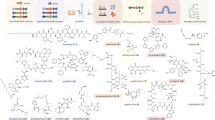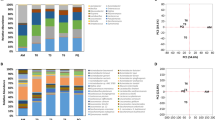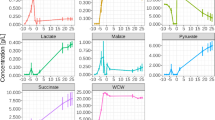Abstract
Different industries have different motivations to probe the enormous resource that is uncultivated microbial diversity. Currently, there is a global political drive to promote white (industrial) biotechnology as a central feature of the sustainable economic future of modern industrialized societies. This requires the development of novel enzymes, processes, products and applications. Metagenomics promises to provide new molecules with diverse functions, but ultimately, expression systems are required for any new enzymes and bioactive molecules to become an economic success. This review highlights industrial efforts and achievements in metagenomics.
This is a preview of subscription content, access via your institution
Access options
Subscribe to this journal
Receive 12 print issues and online access
$209.00 per year
only $17.42 per issue
Buy this article
- Purchase on Springer Link
- Instant access to full article PDF
Prices may be subject to local taxes which are calculated during checkout


Similar content being viewed by others
References
Handelsman, J. Metagenomics: application of genomics to uncultured microorganisms. Microbiol. Mol. Biol. Rev. 68, 669–685 (2004).
Torsvik, V., Ovreas, L. & Thingstad, T. F. Prokaryotic diversity-magnitude, dynamics, and controlling factors. Science 296, 1064–1066 (2002).
Venter, J. C. et al. Environmental genome shotgun sequencing of the Sargasso Sea. Science 304, 66–74 (2004).
Curtis, T. P., Sloan, W. T. & Scannell J. W. Estimating prokaryotic diversity and its limits. Proc. Natl Acad. Sci. USA 99, 10494–10499 (2002).
Ward, B. B. How many species of prokaryotes are there? Proc. Natl Acad. Sci. USA 99, 10234–10236 (2002).
Schloss, P. D. & Handelsman, J. Status of the microbial census. Microbiol. Mol. Biol. Rev. 68, 686–691 (2004).
Burton, S. G., Cowan, D. A. & Woodley J. M. The search for the ideal biocatalyst. Nature Biotechnol. 20, 37–45 (2002).
Maurer, K. H. Detergent proteases. Curr. Opin. Biotechnol. 15, 330–334 (2004).
Homann, M. J. et al. Rapid identification of enantioselective ketone reductions using targeted microbial libraries. Tetrahedron 60, 789–797 (2004).
Piel, J. Metabolites from symbiotic bacteria. Nat. Prod. Rep. 21, 519–538 (2004).
Kaeberlein, T., Lewis, K. & Epstein, S. S. Isolating 'uncultivable' microorganisms in pure culture in a simulated natural environment. Science 296, 1127–1129 (2002).
Zengler, K. et al. Cultivating the uncultured. Proc. Natl Acad. Sci. USA 99, 15681–15686 (2002).
Kirk, O., Borchert, T. V. & Fuglsang C. C. Industrial enzyme applications. Curr. Opin. Biotechnol. 13, 345–351 (2002).
Patel, R. N. et al. Enzymic preparation of (3R-cis)-3-(acetyloxy)-4-phenyl-2-azetidinone: a taxol side-chain synthon. Biotechnol. Appl. Biochem. 20, 23–33 (1994).
Global Industry Analysts. Industrial enzymes — a global multi-client market research project. (GIA, San José, California, USA, 2004).
The application of biotechnology to industrial sustainability. (Organisation for economic co-operation and development (OECD), 2001).
Schepens, H. et al. White Biotechnology: gateway to a more sustainable future [online] <www.mckinsey.com/clientservice/chemicals/pdf/BioVision_Booklet_final.pdf> (2003).
Riese, J. Surfing the third wave: new value chain creation opportunities in industrial biotechnology (McKinsey & Company, Frankfurt, Germany, 2003).
DSM Position Document, Industrial (white) biotechnology: an effective route to increase EU innovation and sustainable growth [online] <http://www.b-basic.nl/documents/DSMIndustrial-white-biotechnology.pdf> (2004).
Herrera, S. Industrial biotechnology — a chance at redemption. Nature Biotechnol. 22, 671–675 (2004).
Schoemaker, H. E., Mink, D. & Wubbolts, M. G. Dispelling the myths — biocatalysis in industrial synthesis. Science 299, 1694–1697 (2003).
Schmid, A. et al. Industrial biocatalysis today and tomorrow. Nature 409, 258–268 (2001).
Schmid, A., Hollmann, F., Park, J. B. & Buhler, B. The use of enzymes in the chemical industry in Europe. Curr. Opin. Biotechnol. 13, 359–366 (2002).
Straathof, A. J., Panke, S. & Schmid, A. The production of fine chemicals by biotransformations. Curr. Opin. Biotechnol. 13, 548–556 (2002).
Roberts S. M. Biocatalysts in synthetic organic chemistry. Tetrahedron 60, 499–500 (2004).
Lorenz, P., Liebeton, K., Niehaus, F. &, Eck, J. Screening for novel enzymes for biocatalytic processes: accessing the metagenome as a resource of novel functional sequence space. Curr. Opin. Biotechnol. 13, 572–577 (2002).
Schloss, P. D. & Handelsman, J. Biotechnological prospects from metagenomics. Curr. Opin. Biotechnol. 14, 303–310 (2003).
Torsvik V. L. & Goksoyr J. Determination of bacterial DNA in soil. Soil Biol. Biochem. 10, 7–12 (1980).
Pace, N. R., Stahl, D. A., Lane, D. J. & Olsen, G. J. The analysis of natural microbial populations by ribosomal RNA sequences. Adv. Microbial Ecol. 9, 1–55 (1986).
Schmidt, T. M., DeLong, E. F. & Pace, N. R. Analysis of a marine picoplankton community by 16S rRNA gene cloning and sequencing. J. Bacteriol. 173, 4371–4378 (1991).
Healy, F. G. et al. Direct isolation of functional genes encoding cellulases from the microbial consortia in a thermophilic, anaerobic digester maintained on lignocellulose. Appl. Microbiol. Biotechnol. 43, 667–674 (1995).
Staley, J. T. & Konopka, A. Measurement of in situ activities of nonphotosynthetic microorganisms in aquatic and terrestrial habitats. Annu. Rev. Microbiol. 39, 321–346 (1985).
Short, J. M. & Mathur, E. J. Production and use of normalized DNA libraries. US Patent 5,763,239 (1998).
Radomski, C. C. A., Seow, K. T., Warren, R. A. J. & Yap, W. H. Method for isolating xylanase gene sequences from soil DNA, compositions useful in such method and compositions obtained thereby. US Patent US 5,849,491 (1998).
Robertson, D. E. et al. Exploring nitrilase sequence space for enantioselective catalysis. Appl. Environ. Microbiol. 70, 2429–2436 (2004).
DeSantis, G. et al. An enzyme library approach to biocatalysis: development of nitrilases for enantioselective production of carboxylic acid derivatives. J. Am. Chem. Soc. 124, 9024–9025 (2002).
Short, J. M. & Keller, M. Method of high-throughput screening of an environmental library. US Patent 6,806,048 (2004).
Knietsch, A., Bowien, S., Whited, G., Gottschalk, G. & Daniel, R. Identification and characterization of coenzyme B12-dependent glycerol dehydratase- and diol dehydratase-encoding genes from metagenomic DNA libraries derived from enrichment cultures. Appl. Environ. Microbiol. 69, 3048–3060 (2003).
Breves, R., Maurer, K. H., Eck, J., Lorenz P. & Zinke H. New glycosyl hydrolases. PCT patent application WO 03/054177 (2003).
iebeton K. & Eck J. Identification and expression in E. coli of novel nitrile hydratases from the metagenome. Eng. Life Sci. 4, 554–562 (2004).
Hobel, C. F. V. et al. Use of low nutrient enrichment to access novel amylase genes in silent diversity of thermophiles. World J. Microbiol. Biotechnol. 20, 801–809 (2004).
Gray, K. A., Richardson, T. H., Robertson, D. E., Swanson, P. E. & Subramanian, M. V. Soil-based gene discovery: a new technology to accelerate and broaden biocatalytic applications. Adv. Appl. Microbiol. 52, 1–27 (2003).
Detter, J. C. et al. Isothermal strand-displacement amplification applications for high-throughput genomics. Genomics 80, 691–698 (2002).
McDonald, A. E. & Vanlerberghe, G. C. Alternative oxidase and plastoquinol terminal oxidase in marine prokaryotes of the Sargasso Sea. Gene 349, 15–24 (2005).
Uchiyama, T., Abe, T., Ikemura, T. & Watanabe, K. Substrate-induced gene-expression screening of environmental metagenome libraries for isolation of catabolic genes. Nature Biotechnol. 23, 88–93 (2004).
Service, R. F. Surviving the blockbuster syndrome. Science 303, 1796–1799 (2004).
Leeb M. A shot in the arm. Nature 431, 892–893 (2004).
Cragg, G. M. & Newman, D. J. Medicinals for the millennia: the historical record. Ann. N. Y. Acad. Sci. 953, 3–25 (2001).
Newman, D. J., Cragg, G. M. & Snader, K. M. Natural products as sources of new drugs over the period 1981–2002. J. Nat. Prod. 66, 1022–1037 (2003).
Osburne, M. S., Grossman, T. H., August, P. R. & MacNeil, I. A. Tapping into microbial diversity for natural products drug discovery. ASM News 66, 411–417 (2000).
Daniel, R. The soil metagenome — a rich resource for the discovery of novel natural products. Curr. Opin. Biotechnol. 15 199–204 (2004).
Seow, K. T. et al. A study of iterative type II polyketide synthases, using bacterial genes cloned from soil DNA: a means to access and use genes from uncultured microorganisms. J. Bacteriol. 179, 7360–7368 (1997).
Wang, G. Y. et al. Novel natural products from soil DNA libraries in a streptomycete host. Org. Lett. 2, 2401–2404 (2000).
Pfeifer, B. A., Admiraal, S. J., Gramajo, H., Cane, D. E. & Khosla, C. Biosynthesis of complex polyketides in a metabolically engineered strain of E. coli. Science 291, 1790–1792 (2001).
Courtois, S. et al. Recombinant environmental libraries provide access to microbial diversity for drug discovery from natural products. Appl. Environ. Microbiol. 69, 49–55 (2003).
MacNeil, I. A. et al. Expression and isolation of antimicrobial small molecules from soil DNA libraries. J. Mol. Microbiol. Biotechnol. 3, 301–308 (2001).
Martinez, A. et al. Genetically modified bacterial strains and novel bacterial artificial chromosome shuttle vectors for constructing environmental libraries and detecting heterologous natural products in multiple expression hosts. Appl. Environ. Microbiol. 70, 2452–2463 (2004).
Quaiser, A. et al. First insight into the genome of an uncultivated crenarchaeote from soil. Environ. Microbiol. 4, 603–611 (2002).
Berry, A. E., Chiocchini, C., Selby, T., Sosio, M. & Wellington E. M. Isolation of high molecular weight DNA from soil for cloning into BAC vectors. FEMS Microbiol. Lett. 223, 15–20 (2003).
Short, J. Screening for novel bioactivities. US Patent US 6,057,103 (2000).
Piel, J. et al. Antitumor polyketide biosynthesis by an uncultivated bacterial symbiont of the marine sponge Theonella swinhoei. Proc. Natl Acad. Sci. USA 101, 16222–16227 (2004).
Richardson, T. H. et al. A novel, high performance enzyme for starch liquefaction. Discovery and optimization of a low pH, thermostable α-amylase J. Biol. Chem. 277, 26501–26507 (2002).
Henne, A., Schmitz, R. A., Bömeke, M., Gottschalk, G. & Daniel, R. Screening of environmental DNA libraries for the presence of genes conferring lipolytic activity on Escherichia coli. Appl. Environ. Microbiol. 66, 3113–3116 (2000).
Rondon, M. R. et al. Cloning the soil metagenome: a strategy for accessing the genetic and functional diversity of uncultured microorganisms. Appl. Environ. Microbiol. 66, 2541–2547 (2000).
Knietsch, A., Waschkowitz, T., Bowien, S., Henne, A. & Daniel, R. Metagenomes of complex microbial consortia derived from different soils as sources for novel genes conferring formation of carbonyls from short-chain polyols on Escherichia coli. J. Mol. Microbiol. Biotechnol. 5, 46–56 (2003).
Knietsch, A., Waschkowitz, T., Bowien, S., Henne, A. & Daniel, R. Construction and screening of metagenomic libraries derived from enrichment cultures: generation of a gene bank for genes conferring alcohol oxidoreductase activity on Escherichia coli. Appl. Environ. Microbiol. 69, 1408–1416 (2003).
Gabor, E. M., de Vries, E. J. & Janssen, D. B. Construction, characterization, and use of small-insert gene banks of DNA isolated from soil and enrichment cultures for the recovery of novel amidases. Environ. Microbiol. 6, 948–958 (2004).
Gabor, E. M. Harvesting novel biocatalysts from the metagenome. Thesis, Univ. Groningen (2004).
Entcheva, P., Liebl, W., Johann, A., Hartsch, T. & Streit, W. R. Direct cloning from enrichment cultures, a reliable strategy for isolation of complete operons and genes from microbial consortia. Appl. Environ. Microbiol. 67, 89–99 (2001).
Gupta, R., Beg, Q. K. & Lorenz, P. Bacterial alkaline proteases: molecular approaches and industrial applications. Appl. Microbiol. Biotechnol. 59, 15–32 (2002).
Rees, H. C., Grant, S., Jones, B., Grant, W. D. & Heaphy, S. Detecting cellulase and esterase enzyme activities encoded by novel genes present in environmental DNA libraries. Extremophiles 7, 415–421 (2003).
Cottrell, M. T., Moore, J. A. & Kirchman, D. L. Chitinases from uncultured marine microorganisms. Appl. Environ. Microbiol. 65, 2553–2557 (1999).
Henne, A., Daniel, R., Schmitz, R. A. & Gottschalk, G. Construction of environmental DNA libraries in Escherichia coli and screening for the presence of genes conferring utilization of 4-hydroxybutyrate. Appl. Environ. Microbiol. 65, 3901–3907 (1999).
Gillespie, D. E. et al. Isolation of antibiotics turbomycin A and B from a metagenomic library of soil microbial DNA. Appl. Environ. Microbiol. 68, 4301–4306 (2002).
Brady, S. F., Chao, C. J. & Clardy, J. Long-chain N-acyltyrosine synthases from environmental DNA. Appl. Environ. Microbiol. 70, 6865–6870 (2004).
Acknowledgements
We would like to thank our collegues at BRAIN AG and particularly C. Schleper of the University of Bergen, Norway, and the Zentrum für Evolutionsforschung und Biotechnologie (ZEB), Darmstadt, Germany, for fruitful discussions and sharing ideas and resources.
Author information
Authors and Affiliations
Corresponding author
Ethics declarations
Competing interests
Both authors are senior managers at BRAIN AG.
Related links
Glossary
- CONSORTIUM
-
Physical association between cells of two or more types of microorganisms. Such an association might be advantageous to at least one of the microorganisms.
- ENANTIOSELECTIVE
-
Selection of a particular enantiomer, one of a pair of stereospecific isomers.
- GREEN BIOTECHNOLOGY
-
Biotechnology applied to agriculture, for example, production of transgenic crop plants with genetically engineered improved pest resistance.
- RED BIOTECHNOLOGY
-
Biotechnology in health care that uses substances produced in the human body to fight disease — medicines, vaccines, diagnostics and gene therapy.
- REGIOSELECTIVE
-
Selection of a change that occurs with a greater frequency at one site than at several other sites, usually involving a structural or positional isomer.
- SYNTHON
-
A molecule used as a chemical building block to synthesize complex compounds.
- WHITE BIOTECHNOLOGY
-
Industrial use of biotechnology, for example, to produce fine chemicals, biofuel, bioplastics, enzymes for use in detergents, food and feed. The boundaries between white, green and red biotechnology are blurred.
Rights and permissions
About this article
Cite this article
Lorenz, P., Eck, J. Metagenomics and industrial applications. Nat Rev Microbiol 3, 510–516 (2005). https://doi.org/10.1038/nrmicro1161
Issue Date:
DOI: https://doi.org/10.1038/nrmicro1161
This article is cited by
-
Characterization of novel proteases identified by metagenomic analysis from dairy stabilization ponds
Applied Microbiology and Biotechnology (2023)
-
Characterization of antibiotic resistomes by reprogrammed bacteriophage-enabled functional metagenomics in clinical strains
Nature Microbiology (2023)
-
Prospecting Microbial Genomes for Biomolecules and Their Applications
Indian Journal of Microbiology (2022)



